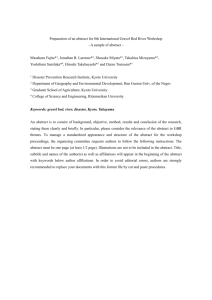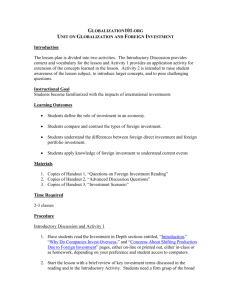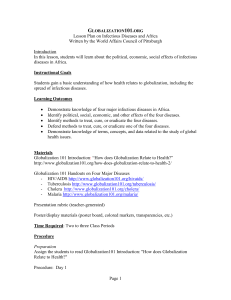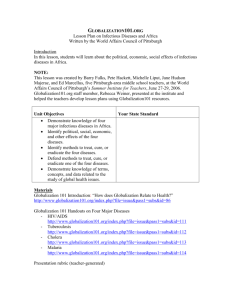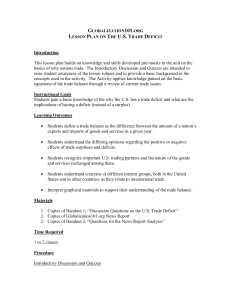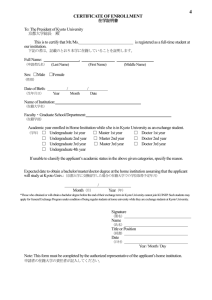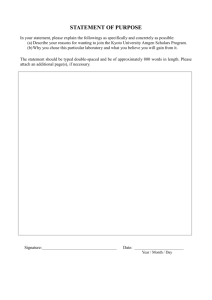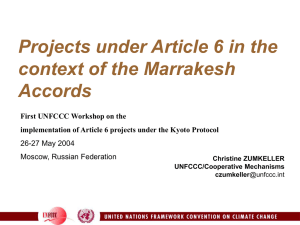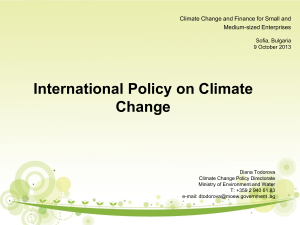Unit on Globalization and the Environment
advertisement
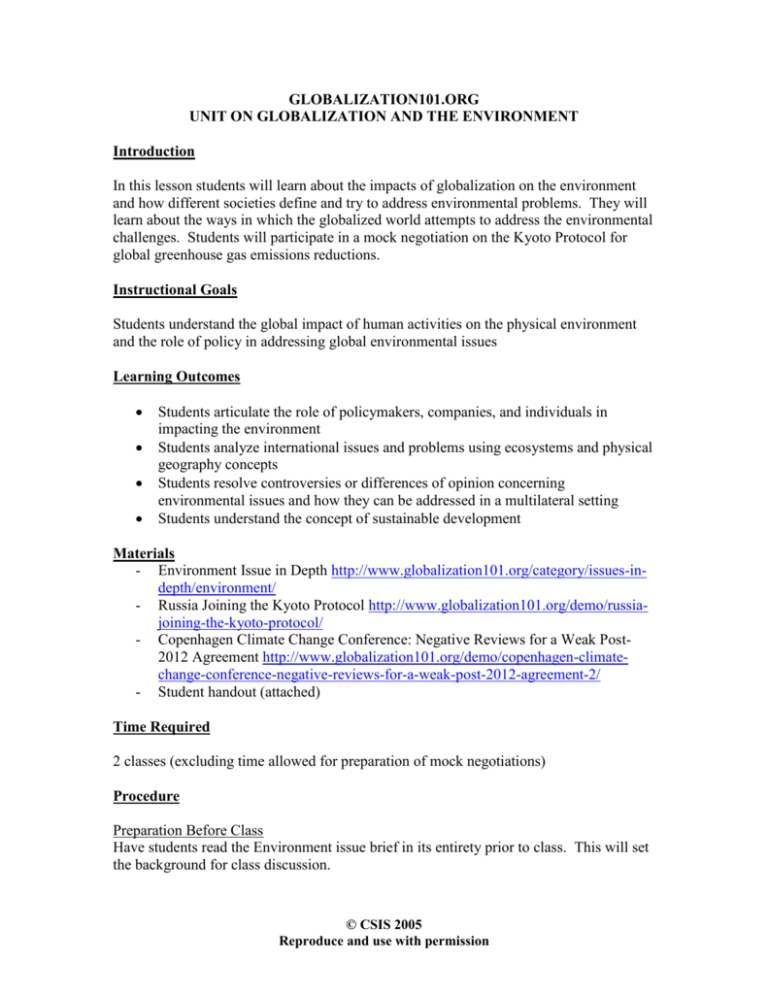
GLOBALIZATION101.ORG UNIT ON GLOBALIZATION AND THE ENVIRONMENT Introduction In this lesson students will learn about the impacts of globalization on the environment and how different societies define and try to address environmental problems. They will learn about the ways in which the globalized world attempts to address the environmental challenges. Students will participate in a mock negotiation on the Kyoto Protocol for global greenhouse gas emissions reductions. Instructional Goals Students understand the global impact of human activities on the physical environment and the role of policy in addressing global environmental issues Learning Outcomes Students articulate the role of policymakers, companies, and individuals in impacting the environment Students analyze international issues and problems using ecosystems and physical geography concepts Students resolve controversies or differences of opinion concerning environmental issues and how they can be addressed in a multilateral setting Students understand the concept of sustainable development Materials - Environment Issue in Depth http://www.globalization101.org/category/issues-indepth/environment/ - Russia Joining the Kyoto Protocol http://www.globalization101.org/demo/russiajoining-the-kyoto-protocol/ - Copenhagen Climate Change Conference: Negative Reviews for a Weak Post2012 Agreement http://www.globalization101.org/demo/copenhagen-climatechange-conference-negative-reviews-for-a-weak-post-2012-agreement-2/ - Student handout (attached) Time Required 2 classes (excluding time allowed for preparation of mock negotiations) Procedure Preparation Before Class Have students read the Environment issue brief in its entirety prior to class. This will set the background for class discussion. © CSIS 2005 Reproduce and use with permission Unit on Globalization and the Environment -2- Introductory Discussion (Session 1) 1) Start by briefly identifying historical human activities (starting with the industrial revolution) that have impacted the environment. The purpose is to introduce students to the interrelationship between human activity, economic and population growth and the environment. 2) Next, discuss what an environmental problem is. Ask students to give examples of environmental problems and their likely causes. Students should be able to explain if and how globalization has increased or reduced the severity of these problems. a) In a diverse classroom with international students, note how pupils from different parts of the world interpret environmental problems. Discuss why this is the case with students. b) If there is not as much diversity in the classroom, ask students to analyze the environmental problem they identified from the viewpoint of a developing country citizen. For example: 1) smog problems from motor vehicles in a developed country versus smog problems from using coal for heating purposes in a developing country, 2) deforestation for agricultural production in a developed country versus deforestation for subsistence farming in a developing country. The following scenario can be used if the students are not participating in the discussion: Suppose one student is a Congolese living on $0.30 a day, and another student is a Bangladeshi living in a flood prone coastal area threatened by a rise in sea levels. Would the students be concerned about global warming? Why, or why not? c) Introduce the concept of sustainable development. Explain how protection of the environment and economic growth could be complementary issues. 3) Using the examples brought up, lead a discussion on the differing viewpoints on what causes an environmental problem. Ask students what they think are the defining characteristics of the different viewpoints. Write the following terms on the board to help prompt discussion: Economic growth and development Societal impacts Governmental responsibilities 4) Give out attached handout to students for the following class debate. Briefly explain the rules of the exercise and divide students into 3 groups (using lottery format), representing the United States, the European Union and China. Mock Debate (Session 2) Follow the instructions on the handout for a mock Kyoto Protocol negotiation session. Evaluate student performance on use of cohesive argumentation, preparation and use of supporting evidence. Observe how the groups behave during the debate and whether they are able to reach a mutually agreeable solution. Note the reasons why the groups have or have not reached consensus. © CSIS 2005 Reproduce and use with permission Unit on Globalization and the Environment -3- Conclusion (Session 2) Using the behavior of students in the debate and the difficulty they encounter reaching an agreement (or continued disagreement), conclude the discussion by asking students what they think is the best way to address environmental problems in such a multilateral setting. Some discussion questions include What is the proper balance between environmental protection and economic growth and development? Are the richer countries responsible in helping poorer countries develop environmentally friendly policies? How can nations cooperate to protect the environment when their interests diverge? © CSIS 2005 Reproduce and use with permission Unit on Globalization and the Environment -4- GLOBALIZATION101.ORG Unit on Globalization and the Environment Handout 1 – Kyoto Protocol Mock Negotiation Session This handout outlines the requirements and the major rules of the mock negotiation session on the Kyoto Protocol. The teacher will go over the main points, but students are encouraged to read this handout in its entirety and be well prepared for the discussion. The negotiation is based on the “Russia Joining the Kyoto Protocol and the Copenhagen Climate Change Conference news analyses, and students’ own research. Students should read the news analyses before beginning their preparation. - Russia Joining the Kyoto Protocol http://www.globalization101.org/demo/russiajoining-the-kyoto-protocol/ - Copenhagen Climate Change Conference: Negative Reviews for a Weak Post2012 Agreement http://www.globalization101.org/demo/copenhagen-climatechange-conference-negative-reviews-for-a-weak-post-2012-agreement-2/ The Negotiation Students will be divided into 3 groups, representing the United States, the European Union, and China. The discussion will be held in the format of a diplomatic negotiation between the 3 groups. Please note down your group and group members below. Student Name Assigned Country Group Members Each group will be asked to research the positions of its assigned country, and make a presentation defending its positions. All students in a group are required to do research and present! The negotiation session will seek to reach a solution on emissions control that all groups can agree on. Students will be evaluated on their use of cohesive argumentation, preparation and use of supporting evidence. Rules of the session 1) This is a formal diplomatic meeting. The teacher will serve as the moderator, and will convene the session. Students are required to address other “delegates” with respect, and use last names. Language used should be appropriate for a diplomatic session. 2) Each group will have 7 minutes to present its position. The use of visual aids, such as PowerPoint or overheads are encouraged, but not required. This time should be used to defend the country’s goals, and rebut any anticipated objections from other © CSIS 2005 Reproduce and use with permission Unit on Globalization and the Environment -5- groups. Proposals that could be amenable to other groups can also be put forward. No other group will be allowed to dispute the presenters during this time. 3) Once all the groups have presented, the moderator will open the floor for a 15-minute discussion. Delegates will be able to rebuke other delegations’ claims, make a stronger case for their position, or propose policies that all parties could agree to. 4) The session will conclude in 15-minutes, even if no agreement is reached. Groups and Research Assignments Once students are assigned their respective countries they should meet with their group members and decide their research strategy. All research materials are available online and students are encouraged to explore different resources. Below are the outlines of the main arguments that provide a starting ground for student research. 1) The United States: The US has indicated that it is against the Kyoto Protocol, on the grounds that it excludes developing countries such as China and India. The administration has also claimed that putting limits on the industry would adversely impact its competitiveness. Students can begin their research at the Copenhagen Climate Negotiations Briefing Book, available online at http://www.usclimatenetwork.org/policy/copenhagenclimate-negotiations-briefing-book. 2) The European Union: The EU is the architect of the Kyoto Protocol and is strongly in favor of environmental regulation. It has already incorporated some of the Kyoto requirements in its laws. Students can begin their research at the European Commission’s Climate Change website, available at http://ec.europa.eu/dgs/clima/mission/index_en.htm 3) China: China is a developing country that has joined the world-trading environment in the late 1990s, and is exempt from the emission reductions proposed under the Kyoto Protocol. However, it has taken voluntary domestic initiatives to address emissions problems. It is in China’s interest to persuade others to constrain their emissions, while at the same time exempting itself from mandatory restrictions. Students can begin their research at the China Climate Change Information Network, available online at http://www.ccchina.gov.cn/en/ © CSIS 2005 Reproduce and use with permission
